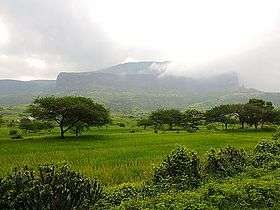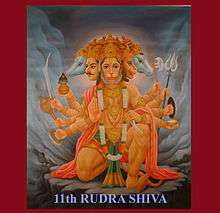Anjaneri
| Anjaneri | |
|---|---|
 Anjineri fort Nasik | |
| Highest point | |
| Elevation | 1,280 m (4,200 ft) |
| Coordinates | 19°55′N 73°34′E / 19.92°N 73.57°ECoordinates: 19°55′N 73°34′E / 19.92°N 73.57°E |
| Naming | |
| Translation | अंजनेरी (Marathi) |
| Geography | |
 Anjaneri Location of Anjaneri, Maharashtra | |
| Location | Nashik, Maharashtra, India |
| Parent range | Trimbakeshwar |
Anjaneri is one of the forts in the mountain range of Nasik-Trimbakeshwar. Anjaneri is located 20 km away from Nasik by Trimbak Road.
History
Anjaneri is one of the exquisite attractions of Nasik city, which is also an important fort in the Trimbakeshwar region. Situated at 4264 feet above sea level, Anjaneri is a spiritual place that lies between Nasik and Trimbakeshwar.
Anjaneri is the birthplace of Hanuman, and is named after Hanuman's mother 'Anjani'.[1] Anjaneri has major significance for devout and hikers alike. Hanuman spent his childhood and grew up on the same mountain.
One hundred and eight Jain caves are found here belonging to 12th century.[2]

Birthplace Controversy
Anjaneri is, according to Hindu texts, the birthplace of Hanuman. The Panchmukhi Hanuman held sacred as the 11th Rudra of Shiva. As Anjaneri is situated very close to the Jyotirlinga of Shiva, having powerful significance of the Trinity, represented by the three faces embodying Lord Brahma, Lord Vishnu & Lord Mahesh(Shiva) at Trimbakeshwar ;it is unquestioningly the birthplace of God Hanuman. Secondly, only as the 11th Rudra is God Hanuman the embodiment of Shiva, and this image is Panchmukhi. This form of Hanuman as "Sri Panchamukha Anjaneya Swami" (Anjaneya = "son of Anjani") is more famous in the South and some other parts of the world. Some of the famous places where this form is seen are: Kumbakonam and Thiruvallur, both in Tamil Nadu.
Unlike Dattatreya who was born with three heads, or Ravana with ten heads, Hanuman was indeed born with one head. So where does this concept of a 5-headed Hanuman come from?
It happened during the war between Rama and Ravana's armies in Lanka. As it so happens, two powerful rakshasa brothers Mahiravana and Ahiravana are fighting on the side of Ravana. In some scriptures they are said to be Ravana's sons and are summoned by their father to help him after many of Ravana's warriors and generals are killed.
Mahiravana is the ruler of the Patalpuri (Patala i.e. Hell). Now Mahiravana, being a powerful practitioner of dark arts and magic (known to be a great devotee of Goddess Kali) locates Rama and Laxmana by his magic. Mahiravana disguises himself as King Dasharartha, and gets past Hanuman's fortress who is guarding them. He captures Rama and Laxmana while they are sleeping, drags them down and holds them captive in his palace in Patala.
Mahiravana leaves a trail behind, which goes deep into the bowels of the earth. Searching for them, Hanuman reaches Patala whose gates are guarded by a creature called Makardhwaja. Hanuman subdues him and ties him up before entering Patalpuri to rescue Rama and Lakshmana.
Upon entering Patala, Hanuman discovers the two brothers held captive as a sacrifice to Kali, and also that in order to kill Mahiravana, Hanuman must simultaneously extinguish five lamps burning in five different directions. Thus, Lord Hanuman assumes the Panchamukha or five-faced form of:
1. Sri Varaha facing the North.
2. Sri Narasimha facing the South.
3. Sri Garuda facing the West.
4. Sri Hayagriva (a much earlier Avatar of Vishnu) facing the sky.
5. His own (Hanuman) facing the East.
Thus equipped with the five faces, Hanuman blows out the lamps, kills Mahiravana (in some versions, he sacrifices the demon himself to Kali, thus earning her favor by virtue of which she made Hanuman her doorkeeper. Indeed, many temples of the goddess are seen to have a monkey guarding their doorways) and thus rescues Rama and Laxmana.
To this day, Hanuman is invoked in any fight against sorcery, and amulets and charms depicting him are therefore extremely popular among devotees.
Some popular folklore has a different version in which Mahiravana is killed, but that does not explain Hanuman's five faces.
Ways To Reach
The primary way to reach the Anjaneri fort is from Anjaneri village. One should get down at Anjaneri Phata, which is 20 km away from Nasik on the Nasik-Tryambakeshwar road. Anjaneri village is at a walking distance of 10 to 15 minutes from Anjaneri Phata. Two pinnacles called ‘Navara’ and ‘Navari’ can be seen from Anjaneri village. The way to fort goes through Anjaneri village itself. Next to that there are some steps, through which we reach the plateau of Anjaneri. It takes almost one and the half hour to reach this plateau from Anjaneri village.
Birthplace of God Hanuman
Anjaneri is a scenic village with mythological importance and spectacular history. From Anjaneri village, it takes about one and half hour to reach the plateau of Anjaneri. This path leads to a magnificent trekking adventure through diverse sceneries of Anjaneri Lake, caves, waterfalls, Healing Lake etc.
Anjaneri Mountain, around 20 km from Nasik, near Trimbakeshwar, is the birthplace of Hindu God Hanuman. A temple dedicated to Anjani, mother of Hanuman is located here. The temple attracts more than 100, 000 devotees during Hanuman Jayanti. The place also attracts large crowd on Tuesdays and Saturdays.The temple is located in the Sahyadri Mountain Ranges and is around 20 km from Nashik. The temple is near Trimbakeshwar.
It takes only 10 minutes to reach the temple of Anjani Mata from the plateau. This temple is quite big. You can see two different ways at a certain distance from Anjani Mata temple; one way to the left hand side that takes you to Seeta cave in 10 minutes. There are two rooms in this cave where almost 10 to 12 people can stay comfortably. There are many beautiful carvings inside Seeta cave. The other way takes you to Citadel, where you can see one more temple of Lord Hanuman and Anjani Mata. It takes 20 minutes to reach this temple.Anjani Temple is built in stone and is situated 4,200 ft above sea level.The right way ahead of the Anjani Mata temple leads directly to the citadel of Anjaneri fort in 20 mins. Here one more big temple of Anjani Mata can be seen. The overall area of Anjaneri is vast.
The place is surrounded by mountain ranges, forests and green landscapes . “Anjaneri” is derived from the fact that God Hanuman is son of Anjani mata, the wife of Pavan. Anjaneri fort is one of the important forts in Trimbakeshwar range.It is located in the beautiful and hilly terrain of Anjaneri Hills-part of the Sahyadri Range in the state of Maharashtra.The 400 meters drive through the Anjaneri village is bound to remind visitors of the state of most Indian village roads. It is quite patchy with many ups and downs, indicative of the nature of human existence, with its joys and sorrows juxtaposed at most times in our lives. The Hanuman Jayanti fair at Anjaneri Village is famous for jatra (procession) and wrestling. A 10 minutes walk from the temple to the left side takes one to the Sita Cave, another place associated with Ramayan.
Trimbakeshwar Jyotirlinga
A 28 kilometre journey from the pilgrim town Nashik takes a tourist to Trimbakeshwar, 10th sacred Jyotirlinga in the Dwadash Jyotirlinga circuit. This hill station like place lies in the formidable shadow of Brahmagiri hills in the Sahyadri range and it is the source of holy river Godavari. The place is also known for its Simhastha Kumbha Mela, which comes every 12 years as per the Hindu calendar.
What makes the Trimbakeshwar Jyotirlinga unique is that it has three faces embodying Lord Brahma, Lord Vishnu & Lord Mahesh(Shiva). All other Jyotirlingas have Shiva as the main deity. The temple is known for its appealing architecture and sculpture.
Trimbakeshwar Jyotirlinga is in a small hollow space, which contains a pot of water. Water from the river Godavari constantly pours over the linga. The Jyotirlinga is unique as it has three faces embodying Lord Brahma, Lord Vishnu & Lord Mahesh (Shiva). Generally the Jyotirlinga has a silver cover on festive occasions it is adorned with a golden cover of five faces each with a golden crown.[4]
Anjaneri's Association to Brahmagiri
Brahmagiri(1298 meters)is to the west of Trimbakeshwar and this fort offers a commanding view of the Jawhar Mokhada region of Thane district. Trimbakeshwar itself is a place of worship because it is one of the 12 Jyotirlingas of Lord Shiva.
From Trimbakeshwar,through regular steps, Ganga dwar is reached and the Gorakshanath cave which is end of Trimbakeshwar.Now again while climbing down,there is a road going towards Brahmagiri towards right.Following this route one reaches the carved steps in the rocks.The steps are very good even in the recent times.They were blown off by Britishers in 1818 but later on, they were rebuilt somewhere before India gained independence.From the base village,Brahmagiri is around 450 to 500 meters elevated
From base village,it takes 45 minutes to see Ganga dwar,the Gorakshanath caves and 108 Swayambhu Mahadev caves and in the halfway while descending,the road towards Brahmagiri takes you till the top in around 45 minutes and almost 2 hours to see the fort completely.There are 2 temples on this fort the place which is believed to be the origin point of Godavari river.From here,the river flows till Ganga dwar and then towards Kushavart teerth in Trimbakeshwar village.
One can reach this place by an ascent of about 750 steps made on concrete. There is a shrine dedicated to Goddess Ganga. The river appears here as coming out from the mouth of Nandi. Kolambika Devi temple and a group of 108 shivalings are seen nearby.
External links
References
- ↑ "Anjaneri, Trimbakeshwar". Must See India. Retrieved 5 February 2012.
- ↑ http://www.jainglory.com/research/anjaneri
- ↑ "AboutShiva.com - About Shiva - Hanuman Jayanthi". About Shiva. 2009-04-09. Retrieved 2012-10-29.
- ↑ "Trimbakeshwar Jyotirlinga". Jyotirlingas.com. Retrieved 2012-10-29.